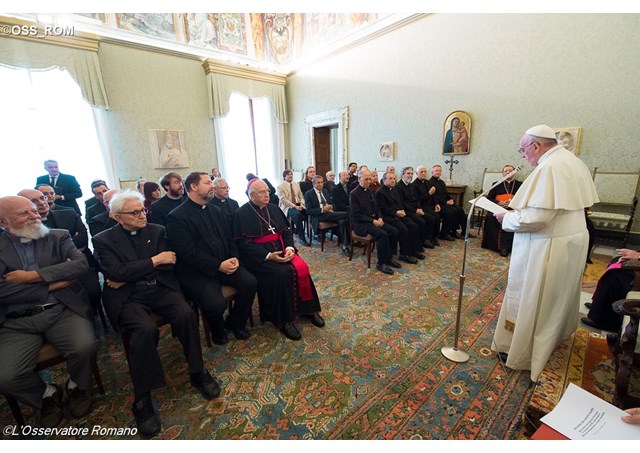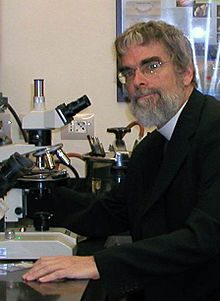(1) TOMORROW’S NEWS TODAY: The Magazine of Fantasy and Science Fiction will be Wikipedia’s featured article of the day on May 15. Thanks to Gordon Van Gelder for the hot tip.
And if you’d like to amaze your friends by predicting what the featured articles will be for some number of days into the future — just change the digits in the URL….
(2) VOICE OF EXPERIENCE. Pat’s Fantasy Hotlist completes its questioning in “Tad Williams Interview, part 2”.
With your wife Deborah, you have an in-house editor perusing everything you write. Then, at Daw Books you have Betsy Wollheim and Sheila Gilbert editing your novels. With that many editors having you under the microscope (and I reckon that your British editor also has something to say before anything goes into print), some would think that it could become a case of too many cooks in the kitchen. And yet, this approach obviously works well for you. Why is that?
Well, for one thing, I’m stubborn. As much as I love and respect all those folks, including my overseas editors, ultimately the complaints and/or suggestions have to make sense to me before I’ll make any large changes. I’ve been doing this writing gig for quite a while now and I don’t think you get to the point I have — making a living at it for decades — without trusting your own instincts. So if one person says they don’t like something, I’ll look at it and consider it but won’t necessarily change it unless the complaint strikes a chord for me. However, if all or at least several of them say that such and such a section is boring or confusing or whatever — well, I’m not stupid. On the other hand, because I have intelligent, skilled readers and editors like the three you mentioned, I also feel I can try new and unusual things and they are all clever enough to understand what I’m trying to do, which gives me a certain sense of freedom combined with the reassuring feeling that if I screw up too badly, they have my back and will help me fix it.
(3) OCTAVIA BUTLER EXHIBIT AT THE HUNTINGTON. It would be commonplace to start an item like this, “I wonder if Octavia Butler would have been surprised to hear that one day she’d be the subject of an exhibit at the Huntington Library?” But after viewing some of the ambitious notes to herself shown in this article, I don’t think it would have surprised her that much. “At the Huntington, see the inspirational note black sci-fi writer Octavia Butler wrote to herself” in the LA Times.
Octavia E. Butler was a powerful and pioneering voice in science-fiction. The first black woman acclaimed as a master of the genre, she was known for vivid, expertly crafted tales that upended conventional ideas about race, gender and humanity.
Although her creations were bold, Butler, who grew up poor in Pasadena, was “a private, reflective person who struggled with shyness and self-doubt,” said Natalie Russell, curator of a new exhibition at the Huntington Library, Art Collections, and Botanical Gardens in San Marino.
How such struggles influenced her life and art is one of the themes explored in “Octavia E. Butler: Telling My Stories.” Russell said the show uses an invaluable resource — the author’s archive — to examine both her published work and “who she was as told through her personal papers.”
(4) CASE STUDY. Paul Linebarger may have written the military classic Psychological Warfare, but don’t assume he didn’t need some shrinkage himself — “Remembering Cordwainer Smith: Full-Time Sci-Fi Author, Part-Time Earthling” in The Atlantic.
One hot June day, probably in the late 1940s or early 1950s, psychoanalyst Dr. Robert Lindner received a phone call from a physician who wanted to refer a troubling case to him for treatment: “The fellow I’m calling you about is a man in his 30s, a research physicist with us out here. As far as I can tell, he’s perfectly normal in every way except for a lot of crazy ideas about living part of the time in another world—on another planet.”
This famous case study, which Lindner shared in his 1955 book The Fifty-Minute Hour, is now believed by some to be a real-life account of Paul Linebarger (1913-1966)—better known to science-fiction fans under the name of Cordwainer Smith, a writer who still retains a strong cult following in this year of his centenary. The accumulated evidence suggests that Smith, who published more than two dozen short stories and a single sci-fi novel during the 1950s and 1960s, may have drawn on his personal experiences, broadly defined, in crafting his peculiar and visionary tales of intergalactic life. Brian Aldiss first reported the possible linkage between Smith and Kirk Allen—the name used by Lindner for his patient—in 1973, and subsequent research by Alan Elms and Lee Weinstein has tended to substantiate, although not definitely prove, the connection.
(5) WONDER WOMAN HEALTH FOOD. Forget those protein bars —
Ahead of the release of the new Wonder Woman movie, Cold Stone Creamery is releasing a fierce new flavor. The promotional flavor is called Dark Chocolate Triple Berry Ice Cream, and the new Creation is called the Wonder Woman Berry Bold, which has the Dark Chocolate Triple Berry Ice Cream plus chocolate shavings, raspberries, and gold glitter. And that’s not all. The ice cream shop is also releasing a new cupcake called Triple Berry Wonder, which has layers of moist Red Velvet Cake and Dark Chocolate Triple Berry Ice Cream, topped with chocolate frosting, gold glitter, and a Wonder Woman logoed Chocolate Medallion.
(6) FAN MAIL. Be part of Worldcon 75’s postcard exhibit –
Send your post cards to:
Worldcon 75; c/o Maa ja ilma ry
PO Box 665; FI-00101
Helsinki, FINLAND— Worldcon 75 (@worldcon75) May 14, 2017
(7) GOLDEN AGE. “Science fiction’s new golden age in China, what it says about social evolution and the future, and the stories writers want world to see” in the South China Morning Post.
…Some 104 original sci-fi titles were published in China in 2016, compared to 75 the previous year, and 461 novelettes were released last year.
Author Regina Wang Kanyu, 27, a long-time sci-fi fan, has witnessed its growth in recent years. “It’s the golden age of Chinese science fiction,” she says.
Wang is a co-founder of AppleCore, a group of mostly university students who get together in Shanghai to read science fiction. It grew from an alliance of several university clubs into a community, and organises film screenings, visits to virtual reality labs and annual festivals.
She now works full time in the science fiction field – as a public relations manager for start-up Storycom by day and a sci-fi writer by night. Storycom purchases and publishes works by Chinese authors, and Wang’s task is to promote them in foreign markets. “We are not simply marketing the works owned by our company, but the entire genre of Chinese science fiction. We would like to increase its influence, outside China and especially beyond the field of literature, into arts and tourism.”
Last month, writers Regina Wang, Wang Yao and Hao Jingfang attended Melon Hong Kong, the city’s first science-fiction conference to bring together Chinese and Western writers….
Note that Wang Yao writes as “Xia Jia”. Regina Wang Kanyu is a contributor to Amazing Stories.
(8) TIME TRAVEL. A zoomable copy of Berenice Abbot’s photo “Newsstand, Southwest Corner of 32nd Street and Third Avenue, November 19, 1935” can be viewed at the Heritage Auctions site.
Travel back in time to the pulp era, when you could have bought a copy of Weird Tales Nov 1935, with a Conan story by R. E. Howard and a letter by Forrest Ackerman, for the original price!
(9) TODAY’S BIRTHDAY BOYS
- Born May 14, 1927 — European Grand Master of SF, H.W. Franke
- Born May 14, 1944 – George Lucas
(10) THE VIEW FROM ECBATAN. Rich Horton carries on with “Hugo Ballot Reviews: Short Story”.
My ballot will look like this:
1) “That Game We Played During the War“, by Carrie Vaughn
Easy pick for me. It was the only story on my nomination list to make the final ballot. (As I’ve noted before, that’s not unusual.) And it’s SF. More importantly, it’s really good. From my Locus review: “”That Game We Played During the War” is a moving piece about Calla, a woman who was a nurse for Enith during their war with the telepathic Gaant people. The war is over, and Calla is visiting Gaant, trying to meet and continue a game of chess she had been playing with Major Valk, whom she had encountered both in Enith and later after she was captured, in Gaant. This version of chess is unusual — because of the Gaantish telepathy — and it’s not so much the point — the point, of course, is how enemies can come to a peaceful meeting (and, too, how telepathy complicates that!)” So — a core SF idea used very well in service of a worthwhile moral point. With good writing and good characters. Works for me.
(11) BLASPHEMY. That’s what John King Tarpinian said when he spotted this LA Times headline: “So many books to help you get rid of stuff (like too many books)”. The related article, at least, does not single out books as targets of the de-cluttering process.
That stuff-to-happiness equation is at the heart of one of the hottest trends in publishing for the last few years. Publishers have been pumping out book after book celebrating the rewards of getting rid of stuff. Japanese author Marie Kondo’s “The Life-Changing Magic of Tidying Up” and “Spark Joy” have sold over 7 million copies worldwide, and she’s got another coming next month: “The Life-Changing Manga of Tidying Up: A Magical Story” a graphic novel which casts Kondo as a kind of joy-sparking Sailor Moon who helps a disorganized young woman get her life in order.
(12) OLD BLUE EYES. He passed away 19 years ago today. Read Steve Vertlieb’s “Sinatra All The Way” tribute at The Gull Cottage.
On the night of Thursday May 14th, 1998, America and the world lost the most iconic, beloved entertainer of the twentieth century. Sadly, it has been nineteen years since the passing of The Chairman Of The Board. William B. Williams assigned that name to Francis Albert Sinatra on his WNEW Radio program a half century ago, and it stuck. No performer either before or since has had the cultural impact of Sinatra. Singer, Actor, Director, Dancer, Painter, Producer, and Social Activist, Frank Sinatra remains the single most influential multi media artist in show business history. On the anniversary of his passage into both history and legend, we take a look back at his remarkable career and commemorate more than one hundred years, as well as one of The Greatest Stories Ever Told, with this retrospective and one hundredth birthday celebration of the life and times of Frank Sinatra.
(13) BROTHER GUY IN THE NEWS. Fan favorite Brother Guy Consolmagno got some ink this week — “The Vatican Is Looking for God in the Stars”.
If you think faith and science can’t share common ground, think again. Experts in both realms met last week at the Vatican Observatory to prove their theory that you can’t have one without the other. “If you have no faith in your faith, that is when you will fear science,” said Brother Guy Consolmagno the Vatican’s chief astronomer, whose works include such titles as “Would you Baptize an Extraterrestrial?”
Brother Consolmagno led the three-day conference called Black Holes, Gravitational Waves and Spacetime Singularities at the Vatican Observatory’s Castel Gandolfo labs outside of Rome, the former papal summer residence that is remote enough to allow for clear stargazing with minimal light pollution.
He challenged astronomers, cosmologists. and other experts in the field who also believe in God to “come out” and talk about the intersection of faith and fact. What he ended up with are talks like, “The Internal Structure of Spinning Black Holes” and “The Big Bang and its Dark-Matter Content: Whence, Whither, and Wherefore.” Not once in the whole program does the word “God” or “religion” even appear, which is rare for a conference sponsored by the Vatican.
(14) A SCRIBE IN KALAMAZOO. Heather Rose Jones has posted her extensive and fascinating notes about the paper sessions she attended at the Medieval Congress in Kalamazoo. For example –
What Did it Mean to Be a Magician in al-Baqillani’s Baghdad? The Social Implications of the Discourse on Magic – Mushegh Asatryan, Univ. of Calgary
(could not be present due to immigration status concerns, but sent paper to be read)
11th c Baghdad, implications of magical practice. Book concerns difference between saintly miracles, tirckery, soothsaying, magic, and ??. Works to distinguish and offers examples. Clear case where theological speculation is informed by social context of author. Life experiences that led the author to compose the work. “Prophetic miracles” (only prophets can perform) vs. “saintly miracles”.
Miracles: something only God can perform, and not others including supernatural creatures. Breaks the usual custom of events. E.g., flying through the air, moving mountains. One test is claim of prophecy. If someone claims to be a prophet and can still perform the action, it’s a miracle not a trick/magic.
Tricks are manipulation of people’s perceptions.
Magic is considered to be real, and is otherwise similar to miracles in breaking the usual course of events.
The author considers these categories in the context of determinism and atomism. Things are considered magic/miracles only because their break the apparent habit of what God wills, but they are still in alignment with God’s will. A magician cannot effect change in an object but any change is due to God’s action. So a magician can’t prove his actions to be proof of prophecy., as God won’t coincidentally break his habits to create the appearance of the effectiveness of his actions. Unless he’s a prophet and they are actual miracles. So if a magician makes a false claim of prophecy, either he must be punished, or the apparent miracle must be made into a natural law (i.e., a habit of God).
While the author condemns Muslim magicians for this reason, he does not do so for Christian or Jewish magicians,. They post no threat to the Islamic power structure of Baghdad, while Muslim magicians did. Internal political conflicts may have been relevant, e.g., Shi’ites were associated with claims of magical powers. (There is discussion of the authority structure with regard to scriptural interpretation.) The author defends the concept/acceptability of magic in order to counter Shi’a magical claims.
[Thanks to Andrew Porter, Gordon Van Gelder, Bill Mullins, Cat Eldridge, Steve Vertlieb, John King Tarpinian, and JJ for some of these stories. Title credit goes to File 770 contributing editor Raymond Chandler, with an assist from John A Arkansawyer.]







